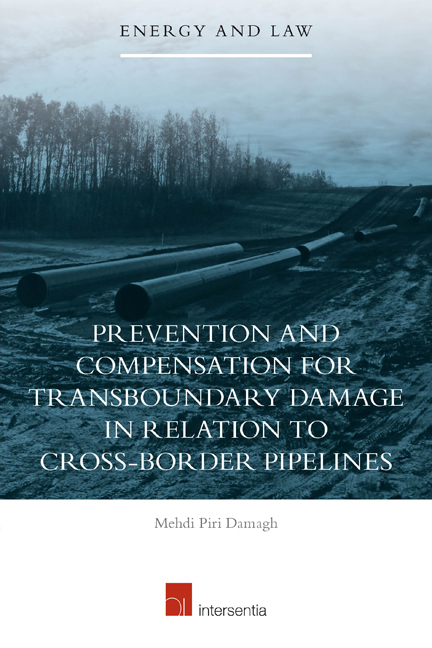Book contents
- Frontmatter
- Dedication
- Acknowledgements
- Contents
- Abbreviations
- List of Tables and Maps
- Chapter 1 Introduction
- PART I INTRODUCTORY ISSUES: PIPELINES, THE NATURE OF RISKS ASSOCIATED WITH PIPELINES AND THEIR REGULATORY REGIMES
- Introductory Note
- Chapter 2 General Features of Cross-border Oil and Gas Pipelines – The Ground Rules
- Chapter 3 Risks and Harm Relared to Cross-border Pipelines
- Chapter 4 Cross-border Pipelines: The International Legal Regime
- PART II PREVENTION OF CROSS-BORDER PIPELINE ACCIDENTS – MEANS AND SOURCES
- PART III STATE RESPONSIBILITY FOR TRANS-BOUNDARY DAMAGE CAUSED BY PIPELINES
- Summary
- Bibliography
- Valorisation Addendum
- Curriculum Vitae
Chapter 3 - Risks and Harm Relared to Cross-border Pipelines
from PART I - INTRODUCTORY ISSUES: PIPELINES, THE NATURE OF RISKS ASSOCIATED WITH PIPELINES AND THEIR REGULATORY REGIMES
Published online by Cambridge University Press: 13 December 2017
- Frontmatter
- Dedication
- Acknowledgements
- Contents
- Abbreviations
- List of Tables and Maps
- Chapter 1 Introduction
- PART I INTRODUCTORY ISSUES: PIPELINES, THE NATURE OF RISKS ASSOCIATED WITH PIPELINES AND THEIR REGULATORY REGIMES
- Introductory Note
- Chapter 2 General Features of Cross-border Oil and Gas Pipelines – The Ground Rules
- Chapter 3 Risks and Harm Relared to Cross-border Pipelines
- Chapter 4 Cross-border Pipelines: The International Legal Regime
- PART II PREVENTION OF CROSS-BORDER PIPELINE ACCIDENTS – MEANS AND SOURCES
- PART III STATE RESPONSIBILITY FOR TRANS-BOUNDARY DAMAGE CAUSED BY PIPELINES
- Summary
- Bibliography
- Valorisation Addendum
- Curriculum Vitae
Summary
INTRODUCTION
A pipeline, as discussed in the previous Chapter is a cost-effective and relatively safe tool for the transportation of oil and gas. Pipelines are extensively used for the terrestrial and submarine transportation of gas. In addition, there are many offshore pipelines for transporting oil from offshore facilities to coasts as well as transmission pipelines which transport oil from one coast to another. Examples include pipelines in the Persian Gulf and in the North Sea. However, provided by various pipeline accident databases, oil and gas pipelines, including cross-border pipelines, can pose major risks both in the construction and operation periods. This is because pipelines are so-called large-scale industrial activities which not only carry flammable and highly unpurified substances, which may pollute the environment, but also the building of a pipeline, which is laid down over long distances, may have adverse impacts on the environment. The first research question asks about the potential harms associated with the construction and operation of (crossborder) pipelines. To answer this question, examining the actual risks of the construction and operation of cross-border pipelines is the first step and identifying trans-boundary damage which might be caused as a result of those accidents is the second step which will be taken in this Chapter.
Oil and gas pipelines are categorized as risky and hazardous activities. This is mainly because they are used to transport a large amount of natural gas or crude oil over a long distance. Further, for technical and economic reasons, natural gas should be transported at high pressures. This increases the possibility of causing major accidents with personal injuries, environmental damage and economic losses. Therefore, unsurprisingly, there have in fact been numerous cross-border pipeline accidents, although exact numbers are difficult to ascertain.
In order to shed some light on the actual risks accompanying pipelines, reports gathered concerning cross-border and cross-country pipeline accidents will be analyzed. Indeed, data on pipeline accidents is mostly gathered by the national and international agencies focusing on the scale and the resulting harm either for national purposes or for commercial interests. Hence, although a few reports in relation to oil and gas pipeline accidents have been prepared at international and regional levels, none of them have specifically dealt with cross-border pipeline accidents.
- Type
- Chapter
- Information
- Prevention and Compensation for Transboundary Damage in Relation to Cross-border Oil and Gas Pipelines , pp. 59 - 124Publisher: IntersentiaPrint publication year: 2015

